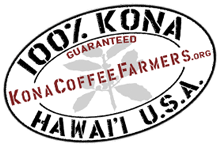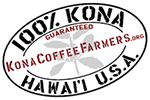Science has not yet proven why certain soil and exposure sites produce finer coffee than others. We can only point to certain correlations between quality coffee with certain varieties of carefully processed arabica coffee and with origins that include well-drained volcanic soils, higher elevations, and seasonal tropical wet-and-dry climates.
Kona’s coffee-growing belt mimics other coffee-growing origins in a way that the rest of Hawaii does not. Kona faces the setting sun. It lies on the western slopes of the enormous volcanoes of Hualalai and Mauna Loa. Kona is sheltered by the mountains from the spanking northeasterly trade winds that dominate the climate of the rest of the state, the Kona mountain rains fall from clouds borne on local sea breezes. The coffee belt occupies ancient Hawaiian agricultural lands that for at least a thousand years supported thousands of Hawaiians on staple crops of taro, sweet potatoes, breadfruit, sugar cane, and bananas. Coffee was introduced to Kona in the 1820’s.
1) Uniquely in Hawaii, the Kona district receives most of its rain in the summer. That replicates the seasons in most of the world’s coffee-growing lands. The clouds that bring rain in the afternoon sea breeze, as they waft upslope, also shelter the coffee from the worst heat of the summer days. The annual rain fall total is 40-60 inches.
2) The coffee-growing belt is tiny by world standards and occupies a very small sector of the larger Kona districts. It extends north to south for about 30 miles if you include the outlying farms in South Kona, separated by 20th Century lava flows from the main northerly portion of the belt. Coffee is cultivated between the altitudes of 800 and 2500 feet. The main coffee belt is scarcely more than a mile wide, owing to the steepness of the mountain slopes.
a. Below 800 feet, it is too dry and hot for coffee to thrive.
b. Above 2500 feet, a natural rain forest naturally prevails, the seasonal rhythm of the rains disappears, and the coffee trees respond by blooming and fruiting all year long, which frustrates practical farming.
c. Elevations above 6000 feet are impractical because they are bone-dry in Hawaii and killing frost sometimes descends as low as 4000 feet.
3) Lava flows form the surface of the Kona coffee belt’s land. Only in the area of Holualoa, has much mineral soil developed on lava flows that date back to the Ice Age. Elsewhere the coffee often appears to be growing on bare lava, with its roots feeding on the humic soil that accumulates in cracks and voids in the rock.
4) Because of several historical collapses of world coffee prices, and because the steep rocky terrain is laborious to cultivate, capital-intensive plantations have not prevailed in Kona. The coffee crop has for a century, come from small family holdings. Today’s specialty coffee boom has encouraged more investment in farms where powerful excavators have smoothed the wild lava surface. But 50 acres remains an exceptionally large farm in Kona, and most of its 700-odd farms comprise fewer than five acres.
5) Professional cuppers report that the higher Kona elevations produce a brighter cup, but in fact, over the years the prize-winning entries in the blind cupping at the annual Kona Coffee Cultural Festival include many farms below 1000 feet elevation.
6) An heirloom variety of coffee — arabica, var. kona typica — produces the balanced and smooth quality of Kona coffee in the cup.


